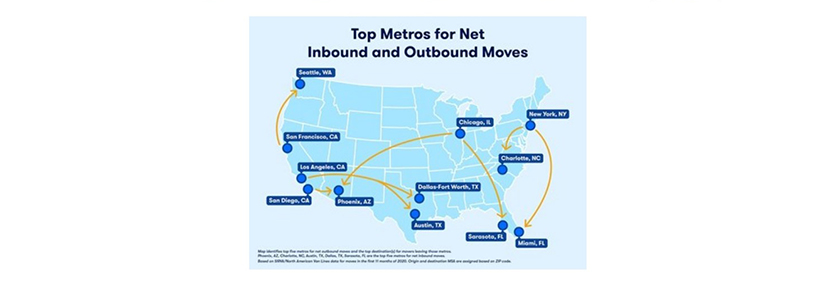
Pandemic Drives ‘The Great Reshuffling’

So many people have moved in the past year—either by choice or by circumstance—that it even has its own name: the “Great Reshuffling.”
A new survey from Zillow, Seattle, finds more than one in 10 Americans (11%) say they have already moved in the past year, contributing to the Great Reshuffling, and millions of additional households could enter the real estate market as a result of the pandemic.
Zillow said the pandemic brought changes that make people more likely to move; and while moving remains challenging, it can also bring more opportunity now than ever before, thanks in part to the rise of remote work.
The survey reported people wanted—or needed—to move, regardless of the pandemic. It said a significant number of homeowners say they’re more likely to move and sell their home as a result of the pandemic, representing an additional 2.5 million households that could enter a real estate market already driven by unrelenting demand.
Life and financial uncertainty are among the top reasons homeowners have not listed their home for sale during the pandemic. The COVID-19 vaccine is likely to change that and prompt many more people to move. Zillow data finds a large majority of homeowners (70%) say they would be mostly or completely comfortable moving to a new home when there is widespread vaccine distribution.
More than one in 10 Americans (11%) have already moved during the pandemic, according to a new survey from Zillow conducted online by the Harris Poll. Among those recent movers, three quarters (75%) say they moved for positive reasons, such as being closer to family or friends or living in an area they’ve always dreamed of. New flexibility to telework has opened up those opportunities for many, and new real estate technology enabled movers to get an immersive experience of a home from hundreds or thousands of miles away, offering added confidence for buyers shopping remotely.
Phoenix, Charlotte, N.C., and Austin, Texas, saw the highest net inbound moves in the first 11 months of 2020, as recent movers sought out relative affordability and warmer weather. Those Sun Belt metros are expected to continue to surge in 2021.
Other data bear these migration patterns. In March, Freddie Mac, McLean, Va., reported the U.S. population in the South and West grew seven times faster than in the Northeast and Midwest between 2017 and 2019.
The report, which analyzed Census Bureau data, said in the South, population growth was mainly attributed to net migration, while in the West, natural increase (more births than deaths) is the main catalyst. Within the South, Texas, Florida and Georgia have witnessed the most increases in population. In the West, it’s Arizona, Washington and Nevada.
“The housing market is now like a Soviet-era supermarket, with most of the shelves empty,” said Redfin CEO Glenn Kelman in remarks during the company’s quarterly earnings call in February. “In the week leading up to this call, demand slackened for the first time in months, probably because of cross-country snowstorms. But prior to that, the stories we heard from our agents were harrowing, juicy and bizarre. Migrations are warping the space-time continuum of small-town economies. The affordability crisis that flowed like some huge, unspent electrical charge from San Francisco to Seattle to Portland to Denver and to Boise is now reaching virtually every town in North America, bringing dazzling prosperity but also new anxieties.”
Data from North American Van Lines also reported some of the country’s largest and most expensive housing markets saw the highest net outbound moves, including New York, Los Angeles, San Francisco and Chicago. Zillow saw for-sale inventory in these metros climb in the city, while inventory nationally hit new lows.
“The pandemic brought an acceleration of trends we were seeing in 2018 and 2019,” said Zillow senior economist Jeff Tucker. “More affordable, medium-sized metro areas across the Sun Belt saw significantly more people coming than going, especially from more expensive, larger cities farther north and on the coasts. The pandemic has catalyzed purchases by millennial first-time buyers, many of whom can now work from anywhere.”
The survey reported nearly a third of recent movers (31%) say they had been dreaming about moving for a year or longer. More than three quarters of recent movers (76%) say emotional factors had been holding them back from making their most recent move. Stress over not being financially prepared to make the move and the expectation that the moving process would be hard or stressful were the most commonly cited factors. Nearly a quarter (23%) of recent movers say the concern that their move would cause stress for their child(ren) held them back from making their most recent move.
Those concerns have merit: about half of all recent movers say they experienced stress (55%) and anxiety (48%) during their most recent move.
However, Zillow reported after their most recent move, more than half of Americans said they experienced happiness (54%) and relief (53%). A vast majority of recent movers – 80% – say their most recent move was worth it.
